The Glory of the Garden
Friday, July 31, 2015
The title for this months News Item comes from a poem by Rudyard
Kipling. I don't consider it to be some of his best work as the
words are rather cliumsily expressed and the meter doesn't flow.
The subject matter however expresses many of the highs and lows of
gardening. As the owner of of a large garden at Batemans in
Sussex (now a National Trust property) he was well qualified
to write about gardening and his poem addresses topics that
all gardeners can readily iidentify with. In the closing sentence
of a long poem he offers up a prayer for the glory of the garden
that it may not pass away. To judge the poem for yourself go to www.kiplingsociety.co.uk/poems_garden.htm
Every July at Cilgwyn we delight in the full glory of more
plants in flower and at their peak than at any other time of year.
Self sufficiency in fruit and vegetables, the mixed borders with
height, scent. colour, variiety and interest, and old
stalwarts continuing for yet another year and refusing to fade
away. And as always still plenty jobs to do and another round
of visitors to welcome to the gardens.
The Paddock Garden in early July
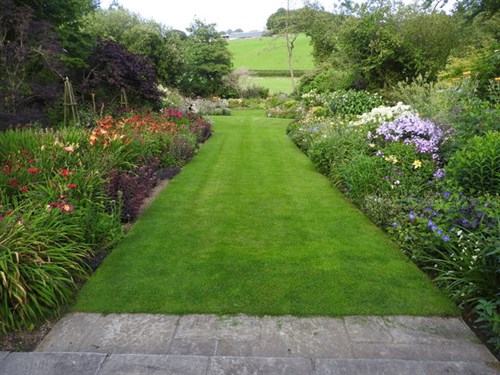
Part of the Paddock Garden later in the
month
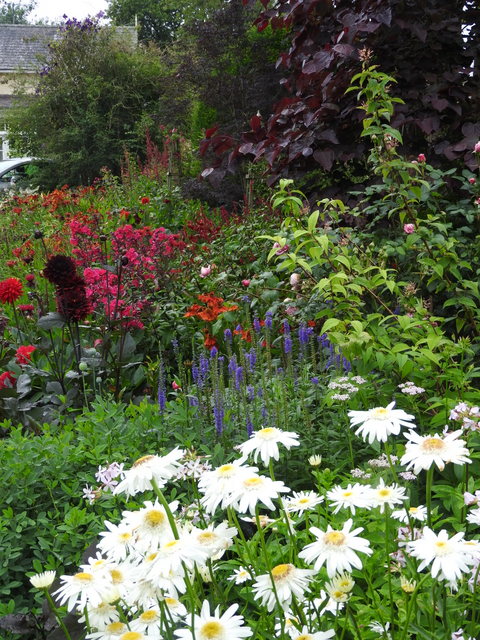
A particular highlight of the month was the success of Jane's
Open Garden Party. Held at Glan yr Afon, Pumpsaint, the home of our
friends Anne and Philip it was a thoroughly enjoyable event, and a
tremendous financial success, and the weather just about
behaved itself. Proceeds have already exceeded well over
£4,000 from a supper evening and auction, the garden opening,
meadow walks, a plant fair, teas, a book stall and many generous
donations, some of which are still coming in. But the best news of
all is that following surgery, Jane has been told that all traces
of the cancer have been removed. She intends to continue raising
money for the Roy Castle Lung Foundation and is already considering
a number of other revenue generating events. She is an
inspiring and hugely energetic person and the best of company. Read
on for many more good news stories in a difficult month.
Left to right:- Steven and Jane, Anne and Philip in
front of Glan yr Afon

The plant fair and on the right a magnicient rose
"Paul's Himalayan Musk" at the peak of perfection scrambling all
over an apple tree. in a glorious riverside setting.

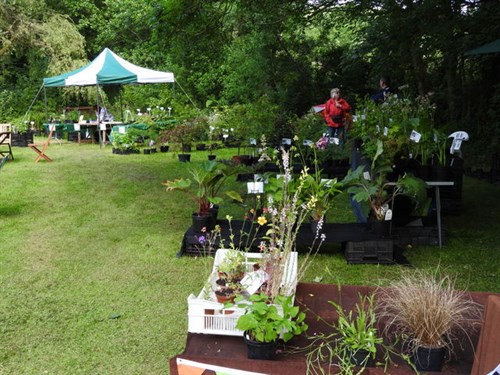
Weather
Summer came in with a bang on 1 July. Hot sunny days and nights,
no wind what a relief, shorts on at last. I have been a bit of a
whimp up to now - or so Moira told me having already been in shorts
on any fine day that came along, and to prove the point even more
she wasted no time in getting into the swimming pool which in the
space of a few days got to 76F. Best of all was to eat evening
meals outside making the most of the longest sunshine hours we have
had here this year. After 6 blissful days Max 24C min
10C it cooleld down a little and by 11 July it was raining, the
persistent colder winds and grey days returned and but for the odd
day that pattern lasted for most ofthe rest of the month.
Max during this time 20C Min 11c. Unlike the balmy south east
no brown lawns here! From 27th it became markedly colder with
single figure night time temperatures culminating on 31st with a
min of 2C, the coldest July temperature I have recorded in 40 years
of living here. August can on;ly be better can't it?!
Garden update
The weather influenced the whole month. The sunshine brought on
most plants and the tunnels, greenhouses and nursery areas needed
watering, sometimes twice a day. The sweet peas and vegetables also
need regular watering The fine spell did not last long enough to
ensure the growth we normally expect at this time of year, with the
result that we are about a week behind. Tender vegetables have been
particularly hard hit. Runner beans only just startied flowering in
the last few days, courgettes not cropping yet. tomatoes in the
tunnels (30 plants in all) which were late anyway are only
setting a second truss now and what a year to choose to grow sweeet
potaoes which need 4 months of warm weather preferably in excess of
21C to produce a good crop!
At least the cooler weather has seen a reduction of pests and
diseases: very little whitefly in protected areas, no botrytis
until later this month on strawberries, potato blight came in early
July as usual but not as virulent as usual with only earlies
affected, Arran Piilot and Charlotte as usual the worst
affected.
Potato beds with 9 varieties in 17 x 6 metre
rows

Some great soft fruit which was long lasting especially
strawberries and the first crop of tayberries from 3 year old
plants. Blackurrants, redcurrants and blueberries too but the
blackbirds have found their way into the fruit cage and they make a
bee line for the blueberries even when they are far from
ripe.
Superb strawbs, a mixture of Elsanta, Red Gauntlet and
the best flavour for me, Cambridge Favourite. They cropped
continuously for 5 weeks.
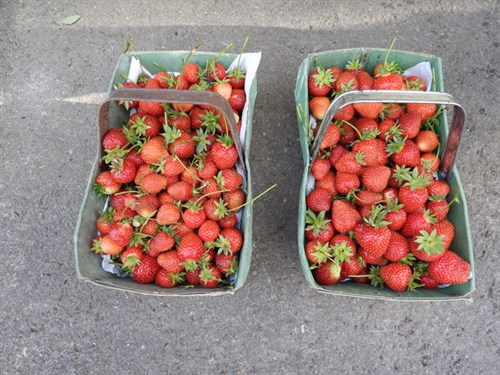
What to do with all the bountiful soft fruit harvest?
Make summer puddings of course. The best ever British
dessert.
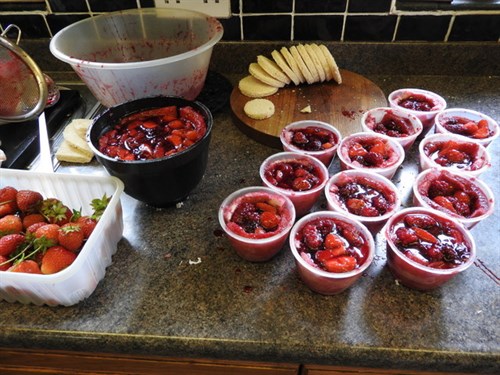
And from one of a few special special plants, a gift
from Ivor Stokes, a former director of Horticulture at the National
Botanic Garden for Wales, an unknown strawberry variety this huge 3
oz. berry held in Moira's dainty hand
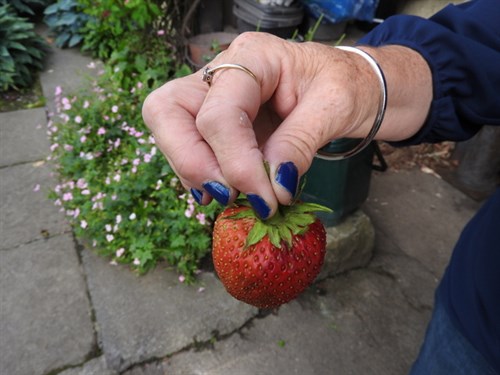
Brassicas however have revelled in the cooler conditions and
although there has been a return of clubroot we have still had a
harvest even from quite badly infected plants. The biggest scourge
however has been carrot fly for which there is no reliable cure
available to home growers. I have so far lost 5 of the seven rows I
have planted. Many of our visitors have reported similar problems.
It is so bad this year that I am considering not growing carrots
next year and they are a year round vegetable staple. So now
because there are no chemical remedies available and many organic
ones seem hit or miss, I shall probably have to buy in carrots that
will have been treated with the chemicals that are not available to
gardeners like me and the many others i come into contact with
during the year.
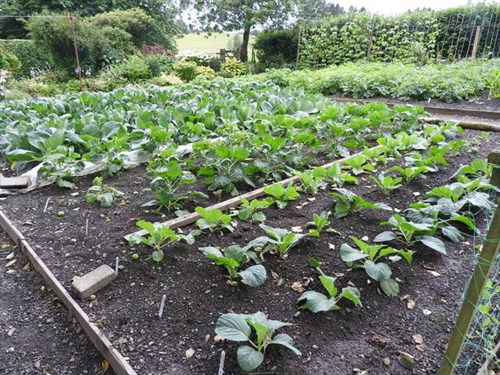
The devastating effect of carrot fly on early sown
carrots - all a total write off
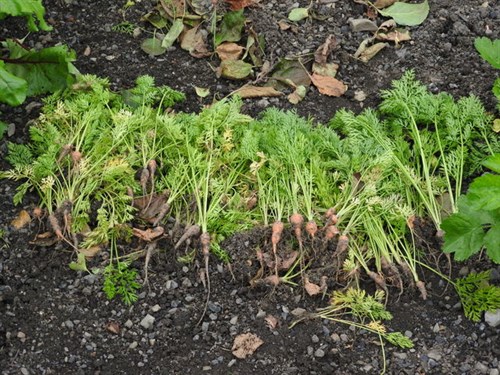
But good crops started to come in regularly from mid
month onwards - later than usual. From left to right:- Cauliflower
"Pavilion", broccoli "Green Marble" salad potato "Belana", beetroot
"Red Ace" and broad bean "Imperial Green Longpod"

The ornamental parts of the gardens have fared much better than
the vegetables.. We now have a the full colour show we expect in
all the borders and in some new colour combinations that have
pleased me. I have planted out most of the annuals and tender
perennials to keep the late summer colour show going and planted
large shrubs in gaps in the main borders - some of them influenced
by the fine specimens we saw earlier this month on a trip to Dinlge
Nurseries and Garden in Welshpool. The Pictorial Meadows Seed Mix I
sowed in May has grown on well but as much of it is in some shade
or overgrown by larger companions in established borders, they are
not as fullsome as they could be but nevertheless are putting on a
good show in a better variety than I expected and sowing seed
direct is much easier than growing on and transplanting plugs of
the same plants.
Red poppies and some umbellifers from Pictorial Meadows
wildflower seed
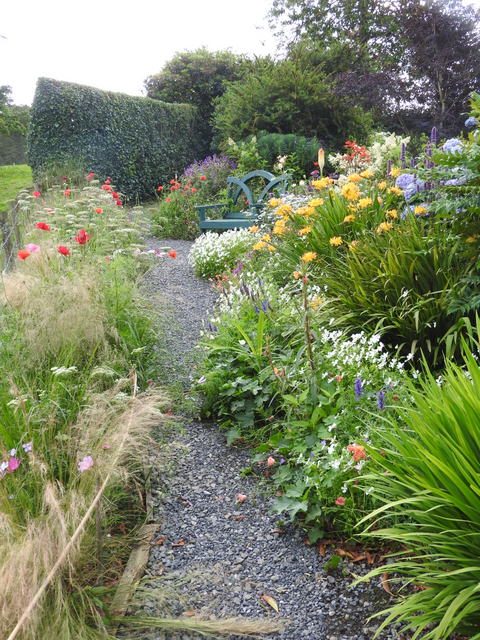
Hydrangeas of all kinds are having a great summer which
is particularly pleasing since the late April frosts threatened to
end all flowerings this year on macrophyllas and serratas.
Hydrangea "General Viscomtesse de Vibraye" is a really good blue in
our PH 6 soil and I particularly like the way the agastache spears
provide contrast to the domes of hydrangea flowers. A special
feature on hydrangreas in next months News Item

And by way of compete contrast just 2 plants contribute
to this pic of shades of grey, a delicate ferny artemesia (var
unknown) with gypsophyila "Baby's Breath" growing through and over
it.

Finally the lawns have kept well and grown on after weeding and
feeding earlier in the month . The scarifying in June paid
dividends and the quality of grass and the colour has improved
considerably
The view across the Paddock Pond showing how the fine
green sward shows off the individual borders to good
effect
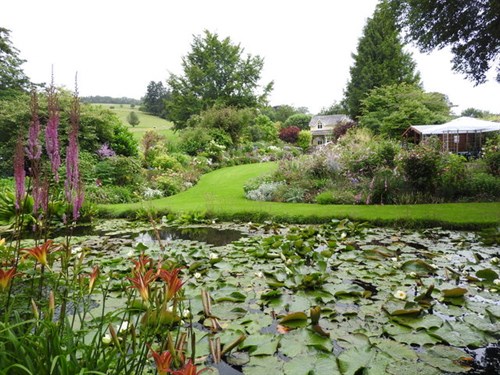
What's looking good?
Too much to express it in words so some pictures of a selection
of the best with apologies to all the others
However I must just say a word about hemerocallis. We have over
well over 50 in the gardens and nursery, many of which are long
established plants, but more recently we have added plants
grown from seed generously made avaialable in the UK by the
American Hemerocallis Society. For years they flowered brilliantly
but for the last 10 years or so they have been badly affected by
hemerocallis gall midge. This year however the mid season forms
which are usually the worst affected have been largely free of the
distorted buds that can ruin the look of the plants and the length
of flowering. This and the colder weather plus daily deadheading
and removal of occasional distorted buds has seen a greatly
extended flowering period and floriferousness (is that a
word?!)
The impact of hems. en masse in the Red
Border
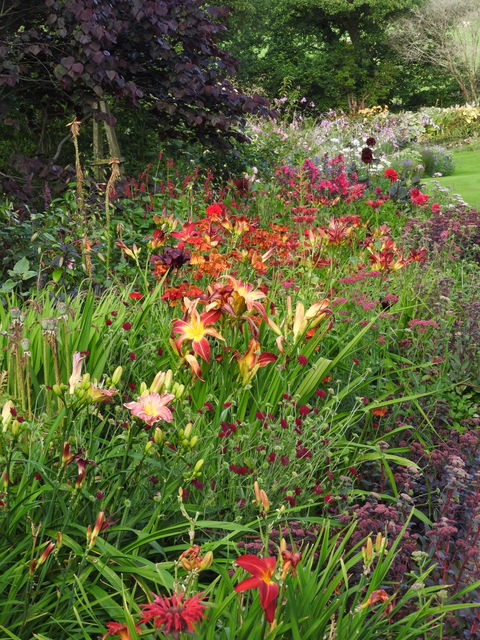
A long established unknown cultivar in a lovely
shade of apricot
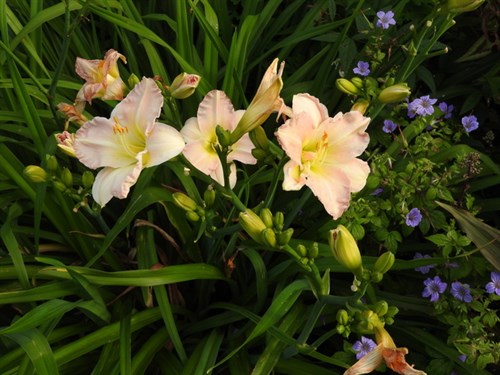
Flowering for the first time this year a rather choice
spider form in an unusual shade of lavender blue; good shaped even
sized petals and and consistent colour.
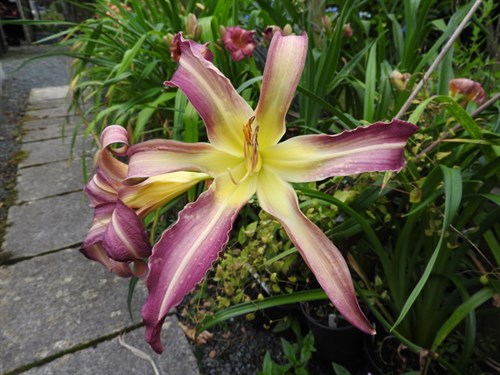
Two flowers on plants from my 2014 sowing of American
Hemerocallis Society seed


A difficult decision to name my favourite hem. in the
garden but if pressed it would probably be h. "Vespers", a very old
cultivar from the 1940's, with trumpet like flowers over a long
period and a pronounced scent
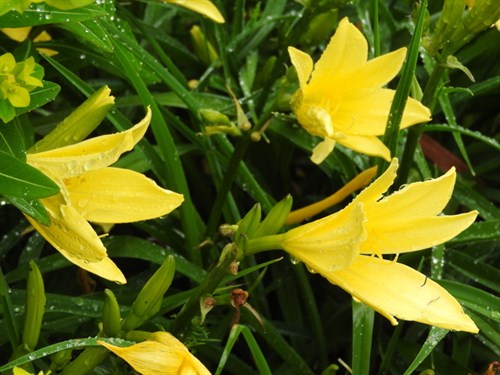
Lobelia tupa all the way from Chile. Strictly half -
hardy it has thrived here since being planted in the red border in
2000. In really dry soil under a yew tree it gets better ever
year
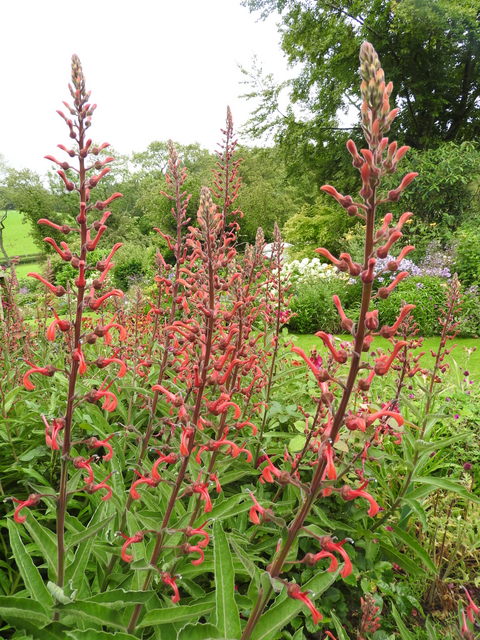
The unique flowers really are something different
probably needing humming birds to pollinate them - what else could
gain access to the flamingo like neck?
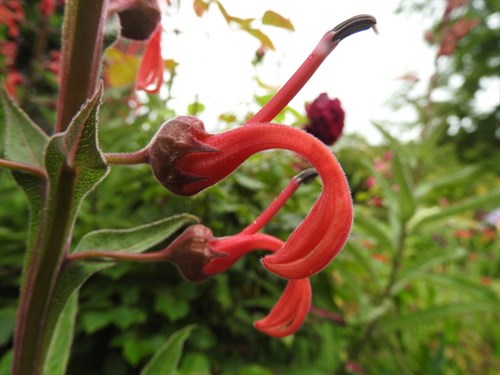
Some good lilies in flower all over the gardens. At the
rear of the Paddock Pond in damp conditions is L. pardilinum, the
so called ditch lily from the western USA. A tall lily at 2
metres

A personal favourite is this species form, lilium
leichtlinii with shining golden yellow spotted flowers and striking
black stems to 1.5 metres
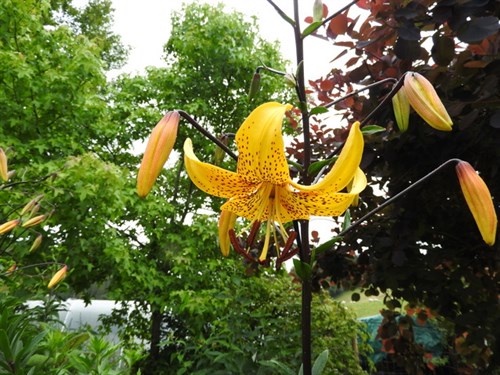
One of the most eagerly awaited flowerings is that of
dierama hybrids mostly from seed companies, plant
society seed exchages and self seedings direct into their flowering
positions.
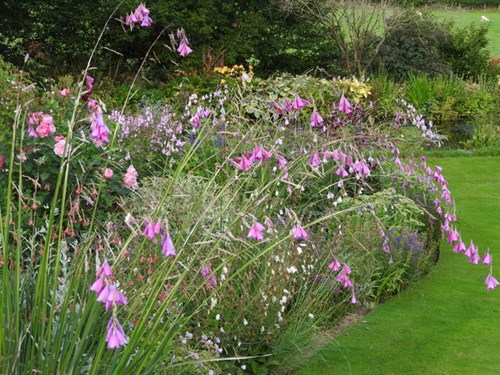
And occasionally from bought in plants like this lovley
cultivar d."Blackbird"

We have a wide range of geraniums in the gardens (who
doesn't?!!) but for me none can top g, pratense "PlenumViolaceum" a
superb double form of the meadow cranesbill - more on them later.
It flowers for up to 6 weeks as it doesn't set seed. It has been in
the gardens since the mid 1990's and is a much treasured
plant.
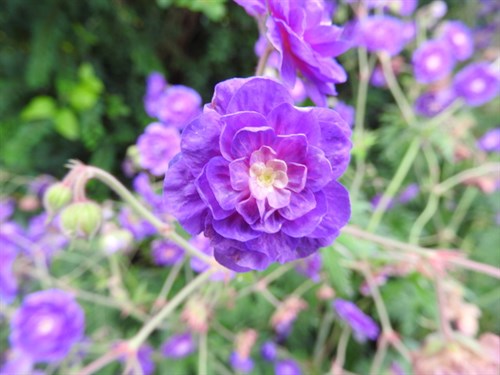
It is easy to take the Paddock Pond for granted because for the
area it covers it is easiest of all similar sized spaces in
the garden to maintain, However when the waterlilies are flowering
as never before and the water is crystal clear with a total absence
of blaket weed, it takes some beating
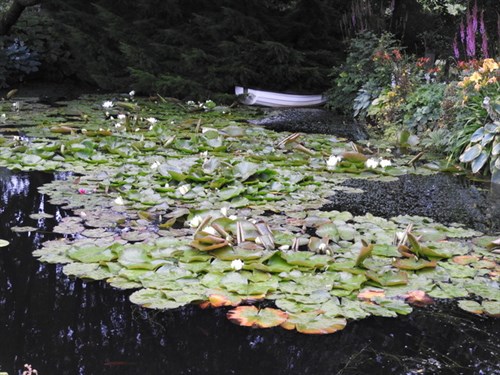
Wildlife and countryside
Not a great deal to report but once again the wildflowers have
stolen the show. Meadows are cropping up everywhere it seems and
with the council cutbacks, we have had no cutting back of all but
the verges on major roads in Carmarthenshire. Usually cut back here
in late May or early June, long before the plants have reached
their peak, we never get to see all the full range of plants along
the verges and certainly not the maturing grass seedheads which are
a delight in themselves. Stars of the month are a wide range of
umbellifers, meadowsweet, ladies bedstraw and huge drifts of
geranium pratense, the meadow cranesbill, rivalling bluebells with
their haze of blue along many roadsides perhaps none better then
the Llandeilo by pass.
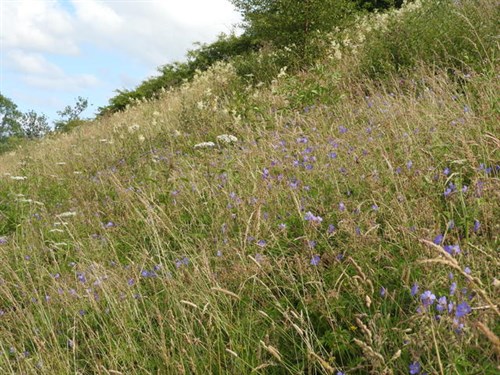
Nearer home in Myddfai in one of the meadows of our
friends Robert and Barry a glorious sunset creates the most
wonderful effect - honestly absolutely no photoshop enhancements -
just pure nature.
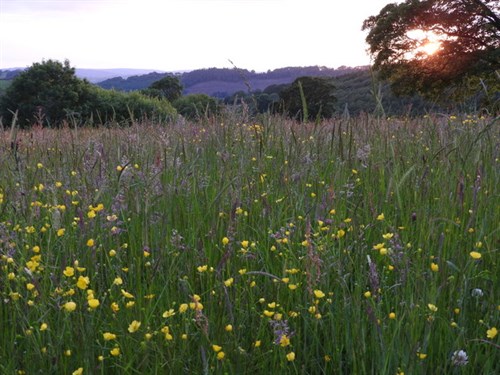

I have scarcely seen a butterfly just the odd comma or two, and
with the cold nights not many moths either. Dragon and Damsel flies
need warmth to become very active. I know from clearing out the
Paddock Pond there are many mature dragonfly nymphs we just have to
hope it warms up soon to enable them to commence the incredible
metamorphisis from a water borne nonentity to a magnfiicent,
brightly coloured flying machine.
A recently hatched female Emperor dragonfly, the
bulkiest UK dragonfly

In contrast a dainty blue damsel fly. To be honest there
are so many similar forms and colours, I haven't a clue of the name
of this one. However from the 2 pics it is easy to see the most
noticeable difference between a dragonfly (wings carried straight
out from the body when at rest), contrasting with the damsefly
whose wings lay straight down the body.
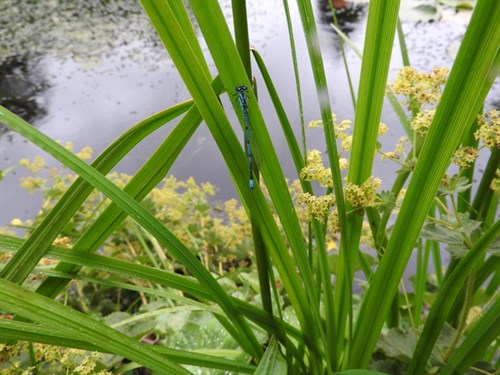
Young blackbirds as always are making a nuisance of themselves
in the fruit cage that they somehow find a way into but for the
life of them they can't find their way out again! Preferred fruit
is blueberries at any stage of ripeness; at a push they will settle
for redcurrants.
Herons are regularly seen and kingfishers have been heard
recently but no sightings yet, and in broad daylight a few days ago
a hedgehog was seen scurrying across the Paddock lawn.
Very quiet on the local farms with little grass harvesting, many
of our neighbours having made the best of the fine weather window
at the beginning of the month which was just as well because in
such changeable and unpredictable weather bringing,in the harvest
especially hay, iis very difficult. With many of the lambs having
gone to market (prices much lower than last year), the surrounding
fields are quieter now.
Visits and visitors
During the month we had a steady stream of visitors to the
gardens and as always met some interesting and deliightful people.
We thank them all for their support. We had friends Sylvia and Tony
visiting in mid month and took the oppourtiny to go visiting
ourselves which was a nice change.
One garden we had to visit was our friends Liz and Paul
at Llwyngarreg, Llanfallteg, open both for the NGS and as a public
garden. 3.5 acres of pure heaven with an amazing range of plants
especially trees and shrubs and perfect planting everywhere. One of
the hidden jewels of Wales. see more on their website at www.llwyngarreg.co.uk

Paul is a master of living willow weaving as in
the case of this incredible latticed multi stemmed tree. There is
also woven seats, archways and huts around the gardens

They also make the most of the many shady, moist areas
in the gardens with huge drifts of plantings of a wide range of
moisture lovers especially primulas

And as former smallholders they still have some
livestockaround the place like this clutch of muscovy
ducklings

Then on to one of my all time favourite places in
Pembrokeshire, Porthclais harbour near St. Davids, hidden away and
almost unchanged since I first visited it nearly 50 years
ago

And on the cliffs drifts of wildflowers the
dominant purple in the pic being a fine form of
heather
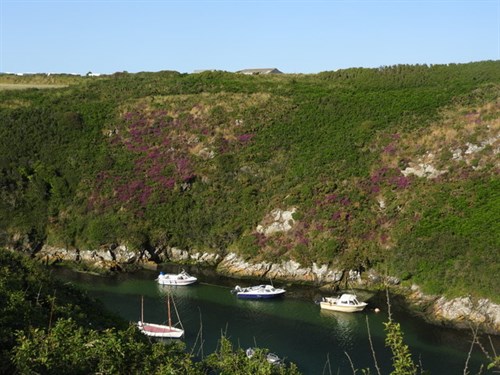
On the cliff tops many parts of Pembrokeshire are
planted with cereals , the wind through the barley creating
beatiful patterns

I have also spent time with our friends Robert and Barry in
Myddfai helping and advising them with the making of ponds and a 40
metre stream garden which was great fun but daunting as it is the
biggest gardening project I have ever been involved with.
Planting of the stream bed after 3 days of construction
by a mighty mechanical digger, including tons of earthmoving
and reshaping of the lie of the surrounding land. More pics next
month to show you how the planting develops

The aim is to have it looking at its best when they have their
first opening for the NGS in 2016. More details nearer the time